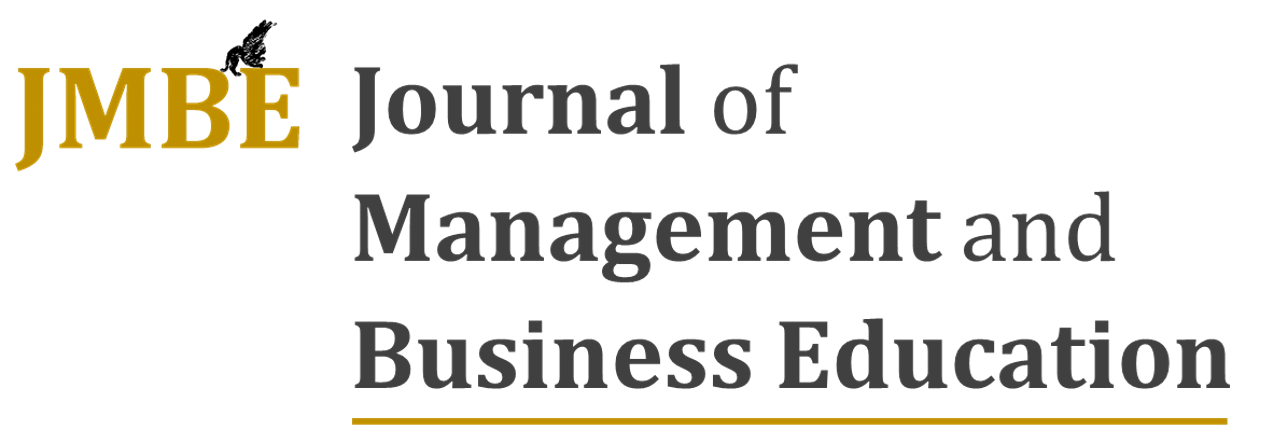Comparative analysis of students´ and professors´ satisfaction levels at the spanish public university
DOI:
https://doi.org/10.35564/jmbe.2019.0005Keywords:
stakeholder, satisfaction, university, high educationAbstract
Public universities´ managers need to understand their stakeholders´ demands and needs. This task appears as a crucial aspect in order to have satisfied students and professors and to achieve the institution´s medium and long-term strategies. The aim of this paper is to analyze the satisfaction levels of both, students and professors in order to study possible improvements. For this purpose, a survey was distributed to students and professors of a Spanish public university and 756 responses were obtained. The results show that students and professors hold different satisfaction levels, which highlights the fact that internal and external stakeholders have diverse perceptions of the same institution. This information enhances the need of developing different strategies when managing the university´s satisfaction levels depending on the stakeholder group under consideration.
Downloads
References
Andrea, I., & Benjamin, S. (2013). University students' needs and satisfaction with their host city. Journal of Place Management and Development, 6(3), 178-191.
https://doi.org/10.1108/JPMD-03-2013-0004
Assaf, A., Tsionas, M., & Oh, H. (2018). The time has come: Toward Bayesian SEM estimation in tourism research. Tourism Management, 64, 98-109.
https://doi.org/10.1016/j.tourman.2017.07.018
Azcárate, R. F. (2006). Estudio de satisfacción del profesorado en la Universidad Pública Española. Empiria. Revista de Metodología de Ciencias Sociales, 11, 175-204.
https://doi.org/10.5944/empiria.11.2006.1113
Barroso, C., & Martín, E. (2000). Desarrollo del marketing relacional en España. Revista Europea de Dirección y Economía de La Empresa, 9(3), 25-45.
Bearden, W., & Teel, E. (1983). Selected Determinant of Consumer Satisfaction and Complaint Reports. Journal of Marketing Research, 20, 21-28.
https://doi.org/10.1177/002224378302000103
Bisquerra, R., & Pérez-Escoda, N. (2015). Pueden las escalas Likert aumentar en sensibilidad? Revista d'Innovació i Recerca En Educació, 8(2), 129-147.
Boshoff, C., & Gray, B. (2004). The relationships between service quality, customer satisfaction and buying intentions in the private hospital industry. South African Journal of Business Management, 35(4), 27-35.
Caballero, C. C., Abello, R., & Palacio, J. (2007). Relación del burnout y el rendimiento académico con la satisfacción frente a los estudios en estudiantes universitarios. Avances En Psicología Latinoamericana, 25(2), 98-111.
Cruz-Suárez, A., Díez-Martín, F., Blanco-González, A., & Prado-Román, C. (2014). Análisis de las relaciones entre la legitimidad organizativa, sus fuentes y dimensiones. Revista Venezolana de Gerencia, 19(65).
Day, R. L. (1984). Modellling choices among alternative responses to dissatisfaction. Advances in Consumer Research, 11(496-499).
del Aguila Obra, A. R., Al-dweeri, R. M., & Meléndez, A. P. (2012). Factores determinantes de la calidad de los servicios electrónicos en el contexto de los operadores postales. Universia Business Review, 3(35).
Diez-Martin, F. (2018). Dónde estamos: Una introducción a la educación en los negocios. Journal of Management and Business Education, 1(1), 1-10
https://doi.org/10.35564/jmbe.2018.0001
Elliott, K., & Healy, M. (2001). Key factors influencing student satisfaction related to recruitment and retention. Journal of Marketing for Higher Education, 10(4), 1-11.
https://doi.org/10.1300/J050v10n04_01
Forgas, S., Molines, M. A., Sanchez, J., & Palau, R. (2010). Antecedents of airline passenger loyalty: Low-cost versus traditional airlines. Journal of Air Transport Management, 16(4), 229-233.
https://doi.org/10.1016/j.jairtraman.2010.01.001
Fornell, C. (1992). A national customer satisfaction barometer: the Swedich experience. The Journal of Marketing, 56(1), 6-21.
https://doi.org/10.1177/002224299205600103
Gento, S. P., & Vivas, M. G. (2003). El SEUE: Un instrument para conocer la satisfacción de los estudiantes universitarios con su educación. Acción Pedagógica, 12(2), 16-27.
Gil, I., Sánchez, M., Berengue, G., & González, M. (2005). Encuentro de servicio, valor percibido y satisfacción del cliente en la relación entre empresas. Cuaderno de Estudios Empresariales, (15), 47-72.
Halstead, D., Dröge, C., & Cooper, M. B. (1993). Product warranties and post-purchase service: a model of cosumer satisfaction with complaint resolution. Journal of Service Marketing, 7(1), 33-40.
https://doi.org/10.1108/08876049310026088
Hanssen, T. E. S., & Solvoll, G. (2015). The importance of university facilities for student satisfaction at a Norwegian university. Facilities, 33(3-4), 744-759.
https://doi.org/10.1108/F-11-2014-0081
Hemsley-Brown, J., & Oplatka, I. (2006). Universities in a competitive global marketplace: A systematic review of the literature on higher education marketing. International Journal of Public Sector Management, 19(4), 316-338.
https://doi.org/10.1108/09513550610669176
Jani, D., & Han, H. (2011). Investigating the key factors affecting behavioral intentions: Evidence from a full-service restaurant setting. International Journal of Contemporary Hospitality Management, 23(7), 1000-1018.
https://doi.org/10.1108/09596111111167579
Jin, N., Line, N. D., & Merkebu, J. (2016). The Impact of Brand Prestige on Trust, Perceived Risk, Satisfaction, and Loyalty in Upscale Restaurants. Journal of Hospitality Marketing & Management, 25(5), 523-546.
https://doi.org/10.1080/19368623.2015.1063469
Johnson, M. D., Anderson, E. W., & Fornell, C. (1995). Rational and adaptive performance expectations in a customer satisfaction framework. Journal of Consumer Research, 21(4), 695-707.
https://doi.org/10.1086/209428
Kotler, P., & Armstrong, G. (2003). Fundamentos de Marketing (Pearson Pr). México.
Lassala, C., Ruiz, C., & Sanz, S. (2007). Implicaciones de la satisfacción, confianza y lealtad en el comportamiento de uso de la banca online. XXI Congreso Anual AEDEM, 1, 46.
Levy, S., & Hino, H. (2016). Emotional brand attachment: a factor in customer-bank relationships. International Journal of Bank Marketing, 34(2), 136-150.
https://doi.org/10.1108/IJBM-06-2015-0092
Liu, L., Wang, Y. S., & Wu, T. J. (2017). Student Satisfaction Scale Development and Application for Sport Management in China. Eurasia Journal of Mathematics Science and Technology Education, 13(5), 1429-1444.
https://doi.org/10.12973/eurasia.2017.00678a
Lovelock, C. L., Walker, R. H., & Patterson, P. G. (2001). Services marketing: an Asia-Pacific perspective (Prentice H). Australia: 2a Edición.
Mano, H., & Oliver, R. L. (1993). Assessing the dimensionality and structure of the consumption experience: evaluation, feeling, and satisfaction. Journal of Consumer Research, 20(3), 451-466.
https://doi.org/10.1086/209361
Martínez-Navalón, J. G., Blanco-González, A., & Díez-Martín, F. (2019). Un análisis multistakeholder de la legitimidad de la universidad. Revista de Investigación En Ciencias Contables y Administrativas, 4(1).
Medrano, N., Mosquera, A., & Melón, A. (2018). Análisis del efecto del uso de herramientas multimedia. Journal of Management and Business Education, 1(3), 210-255.
https://doi.org/10.35564/jmbe.2018.0015
Morgan, R., & Hunt, S. D. (1994). The commitment-trust theory of relationship marketing. Journal of Marketing, 58(3), 20-38.
https://doi.org/10.1177/002224299405800302
Oliver, R. L. (1980). A cognitive model of the antecedents and consequences of satisfaction decisions. Journal of Marketing Research, 17(4), 460-469.
https://doi.org/10.1177/002224378001700405
Oliver, R. L. (1997). Satisfaction: A behavioral perspective on the consumer. (McGraw Hil). Boston.
Roberts-Lombard, M. (2009). Custormer retention strategies implemented by fast-food outlets in the Gauteng, Western Cape and Kwazulu-Natal provinces of South Africa-a Focus on Something Fishy, Nandos and Steers. African Journal of Marketing Management, 1(2), 70-80.
Rufín, R., & Medina, C. (2012). Marketing Público: Investigación, Aplicaciones y Estrategia (Esic Edito). Madrid.
Schlesinger, W., Cervera, A., & Calderón, H. (2014). El papel de la confianza, la imagen y los valores compartidos en la creación de valor y lealtad: aplicación a la relación egresado-universidad. Revista Española de Investigación En Marketing ESIC, 18(2), 126-139.
https://doi.org/10.1016/j.reimke.2014.06.001
Schlesinger, W., Cervera, A., & Perez-Cabanero, C. (2017). Sticking with your university: the importance of satisfaction, trust, image, and shared values. Studies in Higher Education, 42(12), 2178-2194.
https://doi.org/10.1080/03075079.2015.1136613
Sultan, P., & Wong, H. Y. (2014). An integrated-process model of service quality, institutional brand and behavioural intentions The case of a University. Managing Service Quality, 24(5), 487-521.
https://doi.org/10.1108/MSQ-01-2014-0007
Tse, D. K., & Wilton, P. C. (1988). Models of consumer satisfaction formation: an extension. Journal of Marketingrketing Research., 17, 460-469.
Vesel, P., & Zabkar, V. (2010). Relationship quality evaluation in retailers' relationships with consumers. European Journal of Marketing, 44(9/10), 1334-1365.
https://doi.org/10.1108/03090561011062871
Weerasinghe, I. M. S., & Fernando, R. L. S. (2018). Critical factors affecting students' satisfaction with higher education in Sri Lanka. Quality Assurance in Education, 6(1), 115-130.
https://doi.org/10.1108/QAE-04-2017-0014
Westbrook, R. A., & Oliver, R. L. (1991). The dimensionality of consumption emotion patterns and consumer satisfaction. Journal of Consumer Research, 18(2), 84-91.
https://doi.org/10.1086/209243
Wilkins, S., & Balakrihnan, M. S. (2013). Assessing student satisfaction in transnational higher education. International Journal of Educational Management, 27(2), 146.
https://doi.org/10.1108/09513541311297568
Yi, Y., & La, S. (2004). What influences the relationship between customer satisfaction and repurchase intention? Investigating the effects of adjusted expectations and customer loyalty. Psychology & Marketing, 21(5), 351-373.
Downloads
Published
How to Cite
Issue
Section
License
Copyright (c) 2023 Journal of Management and Business Education

This work is licensed under a Creative Commons Attribution-NonCommercial-ShareAlike 4.0 International License.
License terms at: https://creativecommons.org/licenses/by-nc/4.0/legalcode




